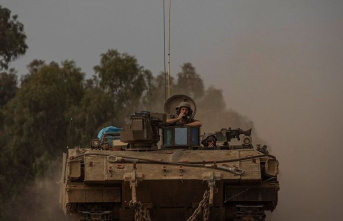The explosions at the Nord Stream 1 and 2 gas pipelines in the Baltic Sea could open a new, dangerous chapter in the dispute between Russia and the West.
There are increasing indications of a targeted destruction - a simultaneous accident in several places seems unlikely. Experts in secret services, the military and industry are now collating their findings into one picture.
How can such an act be carried out? What do you need for this?
Blasting under water is not rocket science, especially when - as in the Baltic Sea - it is not about great depths. Military divers of all nations are trained in it. Thus, sea mines of a possible opponent are usually blown up under water in a controlled manner, not defused. Civil blasting schools also offer such training, as do civil protection authorities such as, in the case of Germany, the Federal Agency for Technical Relief (THW). In principle, however, at least one second method of destruction is conceivable for a pipeline, say technology experts. The tube is serviced with a "pig," a remote-controlled cleaning robot that can be loaded with explosives if perpetrators have access to the system.
Are there any traces of the perpetrators?
The Baltic Sea is one of the best monitored sea areas ever - especially after the escalation of tensions with Russia over the war of aggression against Ukraine. All of the neighboring countries monitor shipping and air traffic with sensors, and there are highly developed skills on the German side. Movements of vehicles in the water are tracked by recording the acoustic signature and comparing it with a database. The navy uses all this information to create an "underwater picture of the situation", which, however, also has its limits when it comes to observing enemy submarines. The evidence also includes the damage to the pipeline. However, because the escaping gas initially bubbles considerably, a more detailed analysis is only possible later - Denmark's Ministry of Defense assumes that it will take one to two weeks before the leaks can be examined at a depth of around 80 meters.
Who would benefit from carrying out this attack?
Who uses it is a common question when looking for the perpetrators. However, there is no easy answer here. Anyone who assumes that Russia is the author believes it is possible that Moscow will permanently damage its own infrastructure and also deny itself the opportunity to switch the gas supply on and off as a means of exerting pressure. In principle, it is also possible that opponents of Russia and these gas pipes wanted to put an end to Moscow's activities. European governments are currently reluctant to assign blame shortly after the fall.
When searching for the possible originator, the authorities involved also ask themselves who has the technical skills to do so. It was heard from the coalition in Berlin that, given the tense situation, it was important not to publish any half-baked information about possible authors, but to wait for reliable results. In general, a "state actor" was considered likely in the event of sabotage - which the EU and NATO assume.
Who is responsible for protecting the infrastructure in Germany?
In June, the CIA warned of a possible attack on the gas pipelines. This warning was probably not very specific and targeted. In any case, it did not trigger any major measures. The security authorities have long been aware that the energy infrastructure in general could be the target of possible sabotage by domestic and foreign actors. Since the start of the Russian attack, federal and state intelligence agencies have repeatedly warned critical infrastructure companies of possible sabotage and cyber attacks. In August, after a visit to the federal police in See, Federal Interior Minister Nancy Faeser (SPD) said: "We must be prepared for attacks on gas terminals and other critical infrastructure."
What protection steps are planned?
Some interior experts in the coalition believe that naming problems here is not enough. In the coalition agreement, the SPD, Greens and FDP had formulated: "We are bundling the physical protection of critical infrastructures in a KRITIS umbrella law. We are strategically realigning the "civil defense" concept." The target could now even be more important, because in the case of a hybrid attack there is a risk that the injured party will in turn seek a target from the opponent. Defense Minister Christine Lambrecht said on Wednesday: "The alleged act of sabotage on the Baltic Sea pipelines shows us once again that we depend on critical infrastructure - including under water. The circumstances of this worrying event must now be clarified quickly and those responsible identified." They have agreed to share information with partner countries. The Navy will contribute to the reconnaissance.
Is pipeline sabotage a warlike attack?
Denmark and Sweden emphasize that they were not attacked. The incidents occurred in international waters in the exclusive economic zones of both countries off the Baltic Sea island of Bornholm. From the point of view of both governments, the question of an attack on Swedish or Danish territory does not arise. Germany is even less affected in this sense - regardless of the long-term consequences.
Is a repair possible?
The operator of the Nord Stream 1 pipeline does not rule out repairing the damaged double strand, at least for the time being. At the moment, however, nothing can be ruled out, a spokesman for Nord Stream AG told the German Press Agency. For an assessment, the damage must first be assessed. So far there are no pictures. Only after an assessment can a possible course of action be determined. There are experiences and providers for corresponding work. The spokesman did not want to provide any information on possible costs and who would assume them because of the lack of information about the damage.
First, unmanned underwater vehicles controlled from ships would have to explore the damage. They want to inspect the damage as soon as possible, but that requires the authorities to lift the restricted zones that have been imposed. Any exploration or even repairs are likely to be difficult for Nord Stream 2 AG because the company has been under US sanctions since the beginning of the year, which make business with the Swiss-based company impossible.
How much gas was in the lines at the time of the damage?
At the time of the sudden pressure drop in one of the two Nord Stream 2 pipelines and both Nord Stream 1 pipelines, the pipes contained a total of hundreds of millions of cubic meters of gas. According to the operator, there were over 170 million cubic meters in the affected Nord Stream 2 tube alone. Nord Stream 1 and 2 are each twin strings of similar capacity.
Does all the gas in the affected lines now escape?
Some of the gas should initially remain in the lines, said Nord Stream 2 spokesman Ulrich Lissek. This is the case when the water and gas pressures reach a certain equilibrium. The gradient over which the lines are laid also plays a role. To his knowledge, it is not possible to release gas at the landing station because the gas escapes faster from the leak. Gas cannot be released suddenly either, because the sudden reduction in pressure creates cold that could damage technical systems. "It's not all that trivial."












